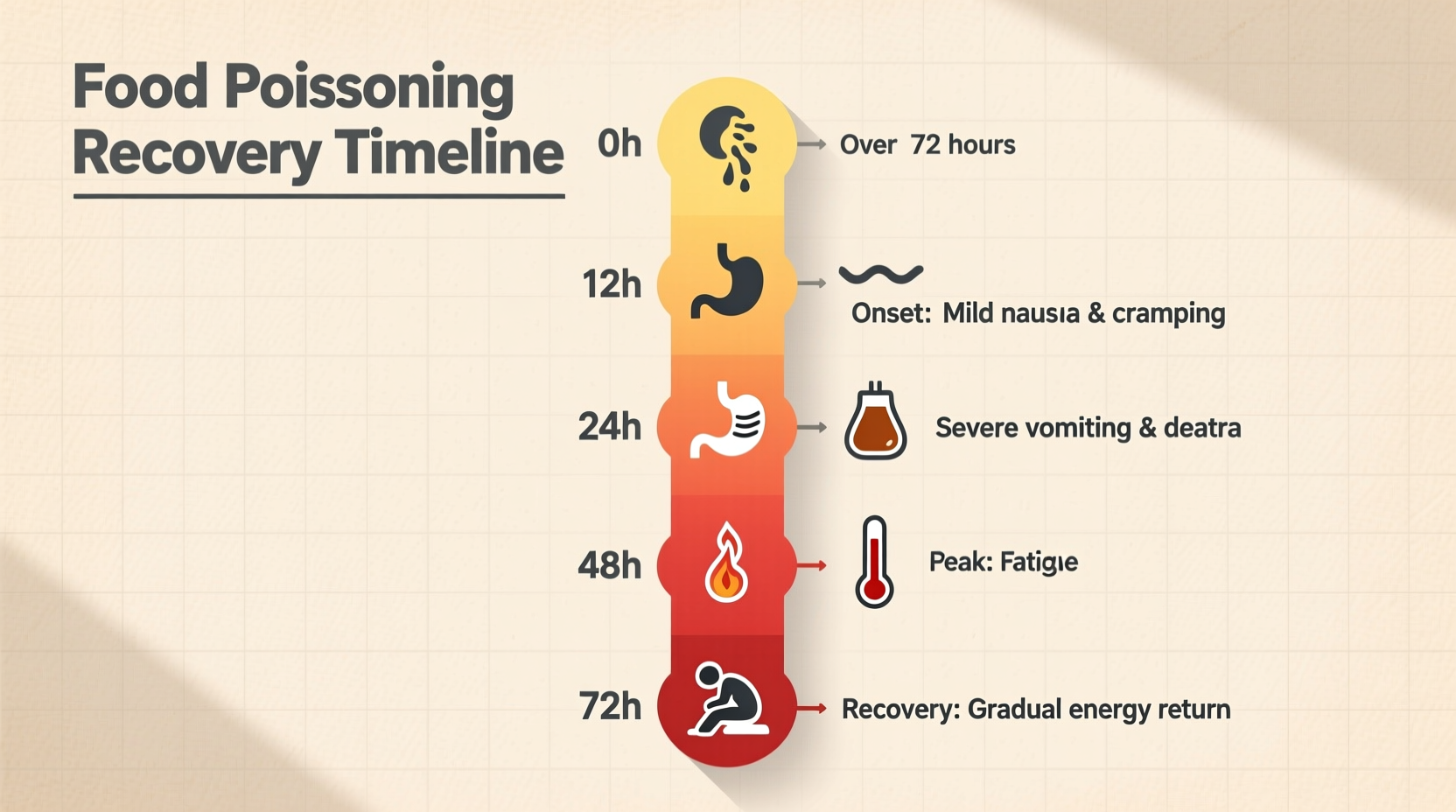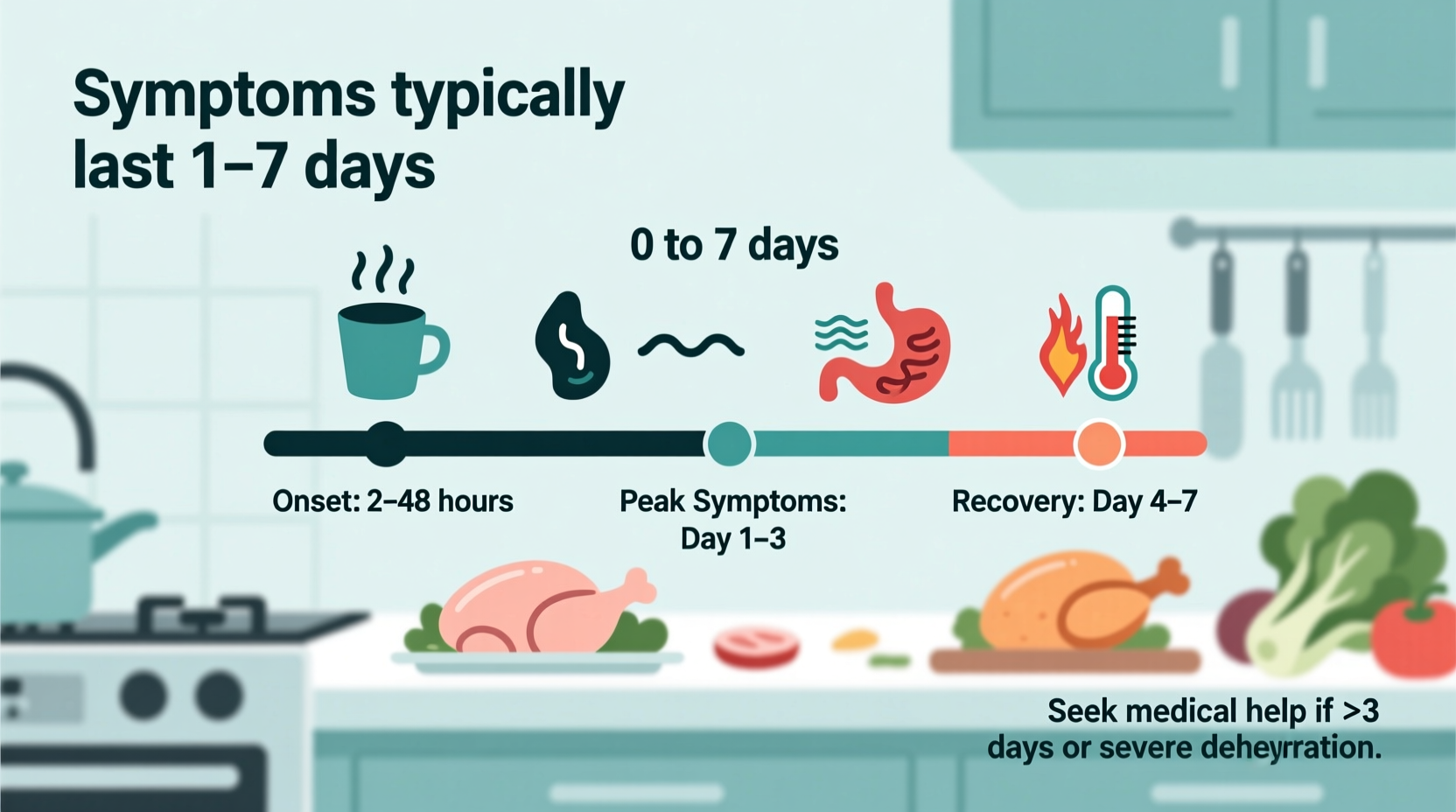Understanding Food Poisoning Duration: What Really Affects Your Recovery Timeline
When food poisoning strikes, one of the most urgent questions is: how long will these symptoms last? This guide provides evidence-based information about food poisoning symptom duration, helping you understand what to expect during recovery.
Pathogen-Specific Duration Guide
| Pathogen Type | Typical Onset Time | Duration Range | Common Sources |
|---|---|---|---|
| Norovirus | 12-48 hours | 1-3 days | Contaminated water, shellfish, ready-to-eat foods |
| Salmonella | 6-48 hours | 4-7 days | Raw eggs, poultry, meat, unpasteurized dairy |
| E. coli (STEC) | 3-4 days | 5-10 days | Undercooked ground beef, raw milk, contaminated produce |
| Rotavirus | 1-3 days | 3-8 days | Contaminated surfaces, person-to-person contact |
| Campylobacter | 2-5 days | 2-10 days | Raw or undercooked poultry, unpasteurized milk |
| Clostridium perfringens | 6-24 hours | 24 hours | Meat, poultry dishes held at unsafe temperatures |
| Cyclospora | 1 week | 2-12 weeks | Contaminated produce, especially imported berries |
Key Factors That Influence Food Poisoning Duration
Your specific recovery timeline depends on several critical factors beyond just the pathogen type:Individual Health Factors
According to the Centers for Disease Control and Prevention (CDC), people with compromised immune systems, older adults, and young children often experience longer symptom duration. The CDC reports that children under 5 and adults over 65 may have symptoms that last 50% longer than healthy adults due to less robust immune responses (CDC Food Safety Symptoms Guide).
Pathogen Characteristics
Some pathogens produce toxins that cause immediate symptoms but resolve quickly, while others invade the intestinal lining, causing more prolonged illness. For example, Staphylococcus aureus produces a heat-stable toxin that typically causes symptoms within hours but resolves within 24 hours, whereas Listeria monocytogenes can cause symptoms that persist for weeks and may require antibiotic treatment.
Treatment Timing and Approach
Early intervention can significantly shorten your recovery period. The Food and Drug Administration emphasizes that proper hydration is the most critical factor in reducing symptom duration for most cases of foodborne illness (FDA Foodborne Illness Guide). In some cases like severe Campylobacter infections, timely antibiotic treatment can reduce symptom duration by 2-3 days.
When Food Poisoning Symptoms Last Longer Than Expected
While most cases resolve within days, certain warning signs indicate your symptoms may persist longer than normal or require medical attention:- Prolonged vomiting (more than 2 days) preventing fluid intake
- Blood in stool or vomit
- Signs of dehydration including extreme thirst, dry mouth, little or no urination
- Fever exceeding 102°F (38.9°C)
- Symptoms lasting beyond 7 days for most common pathogens
Practical Recovery Timeline: What to Expect Day by Day
Understanding the typical progression can help manage expectations during recovery:Days 1-2: Acute Phase
Symptoms typically peak during the first 48 hours with severe nausea, vomiting, diarrhea, and abdominal cramps. This is when dehydration risk is highest. Focus on small sips of clear fluids and electrolyte solutions.
Days 3-4: Transition Phase
For most common pathogens, symptoms begin to subside. Diarrhea may become less frequent, and you might tolerate bland foods like toast, rice, and bananas. Fatigue often persists during this phase.
Days 5-7: Recovery Phase
Most people experience significant improvement by day 5. However, your digestive system may remain sensitive for 1-2 weeks after symptoms resolve. The National Health Service (NHS) recommends gradually reintroducing normal foods while avoiding fatty, spicy, or dairy products initially (NHS Food Poisoning Guide).
When to Seek Immediate Medical Attention
Certain symptoms indicate potentially serious complications requiring prompt medical care:- Symptoms lasting longer than 3 days without improvement
- Inability to keep fluids down for 24 hours
- Signs of severe dehydration (dizziness, rapid heartbeat, minimal urination)
- Neurological symptoms like blurred vision or muscle weakness
- High fever (above 102°F/38.9°C) that doesn't respond to medication
Supporting Your Recovery: Practical Steps to Shorten Duration
While you can't instantly eliminate food poisoning, these evidence-based strategies can help reduce symptom duration:Hydration Strategy
Replace fluids and electrolytes with oral rehydration solutions rather than plain water. The World Health Organization recommends a specific ratio of salts and sugars that optimizes fluid absorption during gastrointestinal illness.
Dietary Approach
Follow the BRAT diet (bananas, rice, applesauce, toast) initially, then gradually expand to include probiotic-rich foods like yogurt once symptoms improve. Recent research published in the Journal of Food Protection shows that probiotics may reduce the duration of certain types of food poisoning by 1-2 days.
Rest and Recovery
Your body needs energy to fight the infection. Prioritize rest during the acute phase, as physical exertion can prolong symptoms. Most people require 24-48 hours of complete rest before gradually resuming normal activities.
Preventing Future Episodes: Reducing Risk
Understanding how long food poisoning lasts is important, but preventing it is better. Follow these evidence-based food safety practices:- Cook poultry to 165°F (73.9°C), ground meats to 160°F (71.1°C)
- Refrigerate leftovers within 2 hours (1 hour if temperature exceeds 90°F/32.2°C)
- Wash hands thoroughly before handling food and after using the bathroom
- Use separate cutting boards for raw meats and produce
- Wash fruits and vegetables under running water before consumption
Remember that food poisoning duration varies, but most cases resolve within a few days with proper self-care. By understanding what to expect and when to seek help, you can navigate recovery more confidently.











 浙公网安备
33010002000092号
浙公网安备
33010002000092号 浙B2-20120091-4
浙B2-20120091-4